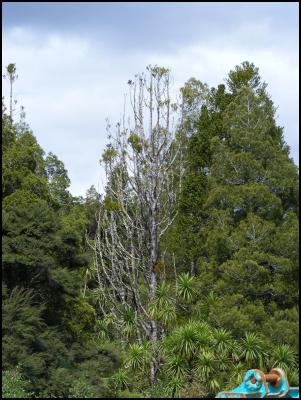Kaimai checks for kauri die-back
Media Release
Kaimai checks for kauri die-back
31 January 2017

Example of a kauri-dieback
diseased tree in Auckland’s Waitakere Ranges.
An aerial search for signs of kauri die-back disease in the northern Kaimai range and surrounding areas will start this week.
“People may notice a fixed wing plane flying in a grid or circular pattern over the Kaimai Mamaku Forest Park and over nearby properties around the Waihī and Katikati areas in the coming weeks,” said Bay of Plenty Regional Council Biosecurity Manager Greg Corbett.
Bay of Plenty Regional Council has pooled resources with Waikato Regional Council to fly over the area as part of a wider search effort which extends over the Coromandel Peninsula and Hunua ranges.
“There’s been no sign of kauri die-back disease reported in the Bay of Plenty to date. The aerial survey is a great opportunity to check that we are still disease-free or to identify die-back symptoms as early as possible, so we can prevent further spread and the loss of local kauri trees,” Mr Corbett said.
The Kaimai Range is the southernmost extent of New Zealand’s kauri tree population. Kauri dieback is caused by a microscopic fungus-like organism called Phytophthora agathidicida. The disease infects kauri roots and damages the tissues that carry nutrients and water within the tree, basically starving the tree to death. Other kauri dieback symptoms include bleeding around the roots and lower trunk. It kills kauri of all sizes, from the smallest of seedlings to the mightiest of giants. Once a tree has the disease there is no cure.
The surveys are being carried out by Waikato Regional Council as part of the National Kauri Dieback programme, and involve co-operation between the Ministry for Primary Industries, Department of Conservation, Bay of Plenty Regional Council, and Auckland Council.
A kauri dieback expert will be aboard the survey plane, looking for yellowing leaves, canopy thinning and/or dead branches. The survey will be carried out over approximately five days during February. The exact dates will depend on suitable weather conditions.
Further kauri dieback information is available at www.kauridieback.co.nz. Bay of Plenty residents should call 0800 STOP PESTS to find out more about the survey or to report kauri die-back symptoms.


 Gordon Campbell: On The Public Sector Carnage, And Misogyny As Terrorism
Gordon Campbell: On The Public Sector Carnage, And Misogyny As Terrorism National Maori Authority: Maori Authority Warns Government On Fast Track Legislation
National Maori Authority: Maori Authority Warns Government On Fast Track Legislation NZ Government: Comprehensive Partnership The Goal For NZ And The Philippines
NZ Government: Comprehensive Partnership The Goal For NZ And The Philippines DoC: Canterbury Spotted Skink In Serious Trouble
DoC: Canterbury Spotted Skink In Serious Trouble Te Pāti Māori: Oranga Tamariki Cuts Commit Tamariki To State Abuse
Te Pāti Māori: Oranga Tamariki Cuts Commit Tamariki To State Abuse NZCTU: Inflation Data Shows Need For A Plan On Climate And Population
NZCTU: Inflation Data Shows Need For A Plan On Climate And Population Statistics New Zealand: Annual Inflation At 4.0 Percent
Statistics New Zealand: Annual Inflation At 4.0 Percent


